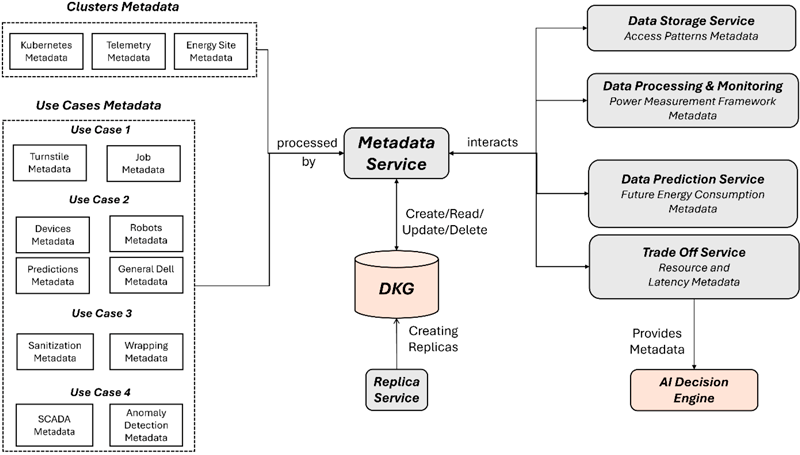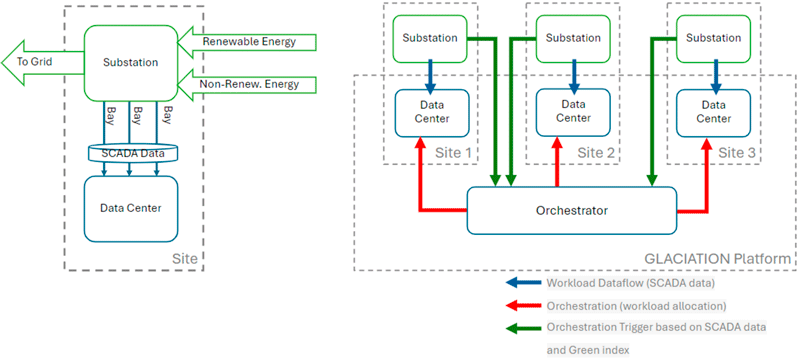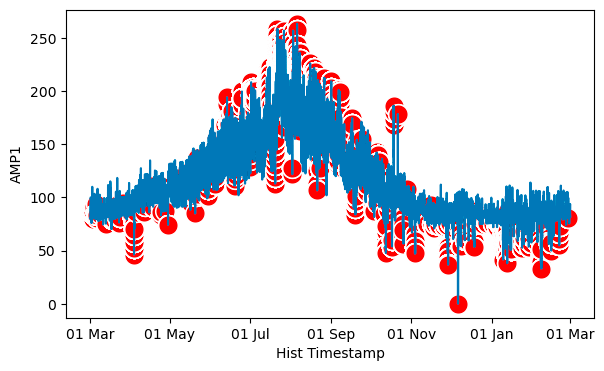by Ioannis Rotskos (IPTO), Orestis Vantzos (IPTO) and Panagiotis Papadakos (ERCIM)
The transition towards sustainable energy systems is accompanied by huge data volumes generated by modern electricity grids. Within the GLACIATION EU project, Use Case 4 (UC4) demonstrates how scalable anomaly detection algorithms and the edge-cloud continuum enable efficient analytics in energy grid management. This use case highlights the deployment of advanced analytics frameworks for processing SCADA data, extracting actionable insights, and optimizing the energy utilization of renewable sources. UC4 employs the GLACIATION platform, which orchestrates distributed workloads across data centers, focusing on sustainability and cost efficiency by leveraging locally produced green energy.
Large-scale data analytics is pivotal in addressing the challenges posed by the integration of renewable energy into electricity grids. Data from Supervisory Control and Data Acquisition (SCADA) systems, which monitor energy transmission infrastructure, require robust processing frameworks for anomaly detection and grid optimization. In the context of the EU-funded GLACIATION project [L1], the Use Case 4 (UC4) led by IPTO, explores the application of distributed algorithms and federated data processing on the GLACIATION platform to enhance grid resilience and operational efficiency, while at the same time taking advantage of available green energy in the grid.
The GLACIATION project is developing a platform that reduces energy consumption for data processing and analytics through AI-enforced minimal data movement operations. This platform enables organizations to deploy and manage analytics across the edge-core-cloud continuum in a secure, energy-efficient, and scalable manner. The GLACIATION platform has been built around the Kubernetes platform [L2] that automates the deployment, scaling and management of containerized applications. A cornerstone of the platform is the use of a Distributed Knowledge Graph (DKG) that spans across the edge-core-cloud continuum and takes advantage of the GLACIATION Metadata Reference Model (GLC-MRM) [L3]. GLC-MRM provides a conceptual model that allows making data ingestion and data processing interoperable for all the use cases of the GLACIATION project. The GLC-MRM model can be considered as a general conceptualization of a task scheduling problem that considers various measuring indicators over the deployed resources. Figure 1 provides an overview of the Metadata Service and its interaction with the core services of the GLACIATION platform.

Figure 1: The Metadata Framework: An overview of the Metadata, the Metadata Service and its interaction with the DKG and the other services.
In the context of the GLACIATION project, UC4 processes multivariate SCADA datasets encompassing current, voltage, and power measurements from three grid substations. Data are sampled at fixed intervals and are enriched with metadata, including sensor specifications, grid topology details and site RES (Renewable Energy Sources) capacity. Workloads run anomaly detection algorithms, generating annotated outputs for actionable insights. The focus is on detecting anomalies that signal faults or inefficiencies, such as a wind turbine disconnect or voltage irregularities. By aligning workload orchestration with green energy availability at each site, the system balances computational demand with renewable energy production, embodying a sustainable approach to data-intensive operations. These outputs are aggregated to inform grid operators and support predictive maintenance. In this way, the platform reduces reliance on non-renewable resources while alleviating grid congestion (see Figure 2).

Figure 2: Schematic of UC4 sites, where a substation of the electrical grid generates measurement (SCADA) data that are consumed by an associated data center. The GLACIATION platform distributes the analytics workloads taking into account the local available renewable energy at each site.
The key contributions of UC4 are the following:
1. Advanced Analytics Techniques:
The anomaly detection algorithms implemented within UC4 include Isolation Forest [R1], One-Class SVM [R2], and rule-based methods (see Figure 3 for an example). These algorithms are optimized for distributed execution, handling the inherent variability and scale of grid telemetry data.
2. Edge-Cloud Continuum:
Data centers near grid substations operate as part of a Kubernetes-based cluster. This infrastructure supports dynamic workload assignment based on real-time energy availability, showcasing the potential of federated data analytics in renewable energy applications.
3. Competency Queries for Operational Insights:
The system addresses critical queries, such as computing average renewable energy usage, evaluating workloads based on the Green Index, and identifying grid segments that meet specific renewable production quotas. These insights support operational decisions and enhance grid management. GLC-MRM was extended to capture the requirements of UC4, such as energy resources and grids, physical locations, the anomaly detection workloads and the SCADA data (see Figure 3).

Figure 3: The graph illustrates the results of an anomaly detection algorithm applied to the current measured by a Remote Terminal Unit (RTU) over a specified time-period. Red dots highlight detected anomalies in the current production.
UC4 demonstrates the transformative potential of large-scale data analytics in the renewable energy sector. The integration of scalable anomaly detection algorithms, edge-cloud architectures, and green energy optimization showcases a novel approach to sustainable grid management. These insights contribute to the broader discourse on Big Data ethics, energy analytics, and the social implications of mass data processing.
The following colleagues also contributed to this article: Dimitrios Brodimas (IPTO), Theodoros Grigorakakis (IPTO), Dimitrios Skipis (IPTO), Michalis Mountantonakis (ERCIM), and Rigo Wenning (ERCIM).
Links:
[L1] https://glaciation-project.eu/
[L2] https://kubernetes.io/
[L3] https://glaciation-project.eu/MetadataReferenceModel/1.1.0/
References:
[1] W. S. Al Farizi, I. Hidayah, and M. N. Rizal, “Isolation forest based anomaly detection: A systematic literature review,” in 2021 8th International Conference on Information Technology, Computer and Electrical Engineering (ICITACEE), Sep. 2021, pp. 118–122.
[2] N. Seliya, A. Abdollah Zadeh, and T. M. Khoshgoftaar, “A literature review on one-class classification and its potential applications in big data,” J. Big Data, vol. 8, pp. 1–31, 2021, doi: 10.1186/s40537-021-00446-9.
Please contact:
Orestis Vantzos, IPTO, Greece
Panagiotis Papadakos, ERCIM, France











